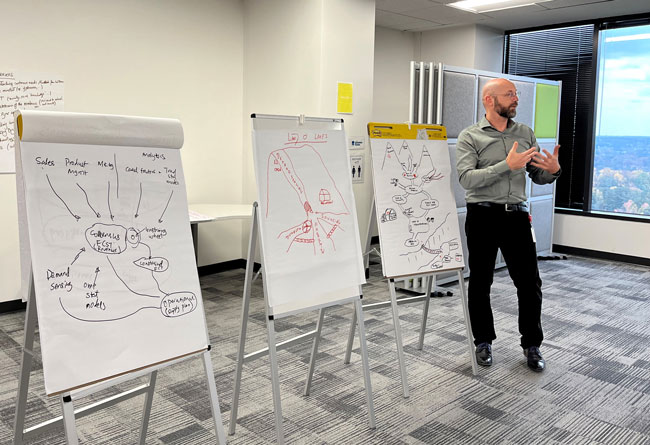
What’s wrong with today’s supply chain planning strategies?
Jo Vernelen and Lennert Smeets - February 8, 2023

The recent chain of disruptive events has had a severe impact on global supply chains. To meet the challenge, supply chain leaders are rethinking the way planning is done.
Joining forces with our customers, OMP is now launching the Spark Initiative to find better ways to incorporate the agility and resilience required by the current market situation. This think tank will test and validate outside-in supply chain planning, a new approach that radically reduces demand latency by focusing on capturing important demand and supply signals closer to the source.
Two of OMP’s experienced product managers and members of the think tank, Jo Vernelen and Lennert Smeets, in conversation: Lennert begins with an observation that traditional planning practices are bumping up against their inherent limitations.
Planning in times of disruption
Blog post

Lennert Smeets: “In times when there’s extreme demand variability, making forecasts entirely based on historical data doesn’t work. Likewise, it’s not enough to look just at incoming orders if you want to know what the actual market trend is. Using the order signal as a proxy for the actual demand will result in bullwhip effects if extremely unexpected things happen on the demand side. Then you’ll either have big shortages or you’ll be building up huge overstocks.”
“The same goes for estimating lead times in periods of unpredictable material shortages and other supply disruptions. We need a planning strategy that goes beyond relying on steady-state insights.”
Jo Vernelen: “Traditional planning strategies link demand and supply through an elaborate set of processes spread over different time horizons. That works pretty well in a stable market situation, but not when the tide is high and a ship is blocking the Suez Canal, to give just one example.”
Blog post
Leveraging signals from the outside world
Blog post
Lennert: “As a planner, you need a much more agile and collaborative environment where you can quickly run through a few scenarios and make ad hoc decisions. You simply don’t have the time to wait for the next monthly S&OP meeting a few weeks ahead. These meetings are still important to align supply chain operations with company strategy but, when there’s disruption all around, they simply lag behind.”
Jo: “That’s why in the Spark Initiative we’re setting up ways to capture and interpret signals from the outside world as early indicators of variability, both on the demand and the supply side. For instance, point-of-sales data will show a peak in demand much sooner than an inventory replenishment order. We’ll test if it would be possible to disseminate such signals efficiently through the supply chain organization to support rapid decision-making.”
Blog post
A major step forward for outside-in planning
Lennert: “The Spark Initiative aims to answer questions like: What if procurement were aware of the constraints their suppliers are facing? What if sales had real-time insights into what’s happening in the retail warehouses? Could companies benefit from using this information to adjust their decision-making processes? Would they develop other KPIs that are more helpful in dealing with the kind of variability we’re talking about here? And how would we measure all this?”
Blog post

Jo: “In this co-ideation initiative, OMP works closely with a number of forward-thinking global customers and academic minds to make outside-in planning a reality. It presents a multi-faceted challenge with many open questions. We don’t have all the answers yet, but we’ll be testing the approach with real-world data, which will give us insight into the opportunities. That will be a major step forward.”
Lennert: ”The big question for our customers is how their planning processes will need to change to support outside-in planning. These new insights will allow them to apply outside-in planning at scale to benefit their entire supply chain.”
Blog post

Jo Vernelen
Senior Product Manager at OMP BE
Biography
With a mountain of expertise in S&OP and supply chain optimization in chemicals, consumer goods, and food & beverages, Jo now focuses on enhancing the user experience, empowering customers with the actionable visibility to handle every situation.

Lennert Smeets
Senior Product Manager at OMP USA
Biography
Lennert oversees the R&D of OMP for Demand Management. He is mostly driven by looking for innovations that make our customer’s demand planning journey more manageable and, at the same time, more effective.






